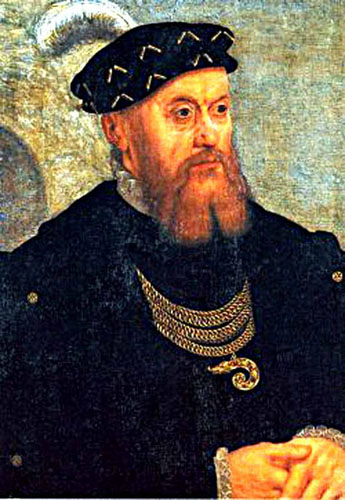| Introduktion

| | 1500-tallet var renæssancen og reformationens århundrede i Øresundsregionen.
Første tredjedel af seklet var præget af magtkampe mellem kongen, og de fire stænder. Kampene kulminerede i den såkaldte, grevens fejde, hvor kongen, Christian 3., og adelen fik styrket deres positioner
Vejen var hermed åbnet for reformationens definitive sejr i 1536, og kirken mistede hermed sin stærke økonomiske og politiske magt
I 1500-tallets sidste del skete der et enormt opsving i indenrigs og udenrigshandelen, hvilket medførte store indkomster via Øresundstolden.
Formuerne blev bl.a. anvendt til opførelse af kongens og adelens fornemme slotte og herregårde. |
Tiden omkring år 1500 betegner overgangen fra middelalder til renæssance. Renæssance betyder genfødsel (af italiensk: Re-nascio) og henviser til den omfattende genopdagelse, genanvendelse og videreudvikling af viden og teknik fra den klassiske tid, som tager sin begyndelse i Norditalien i 1300-tallet, og i løbet af 1500-tallet forplanter sig til det nordvestlige Europa.
Efterhånden kommer renæssancebegrebet også til at dække over en mere samlet, ny, eller om man vil, moderne virkeligheds- og menneskeopfattelse, med vægt på individets skaberevner og trang til at udforske omverdenen. Mennesket fremstår som individ og skaber virkeligheden i sit eget billede.
Tendensen iagttages tydeligt med portrætkunstens udvikling indenfor malerkunsten. Kongelige, adelige, borgerlige lader sig afbilde individuelt og også kunstneren fremstår efterhånden som navngiven person.
Kong Christian 2. (1513-23) fremstår som den tidstypiske regent og renæssancefyrste: På engang despotisk og fremsynet. Han ser byerne og borgerskabet som fremtiden, men formår ikke realisere sine visioner.
Inden for kirken styrkes reformkatolske strømninger under påvirkning af renæssancehumanismen. Malmø bliver litterært arnested for reformationen, som bl.a. starter med fordrivelse af franciskanermunkene inden 1536.
Kongemagten styrkes med inddragelsen af kirkens ejendom ved reformationen i 1536. Klassekampe imellem konge, adel og bønder, som kulminerer i forbindelse med Grevens Fejde 1534-36, gør tiden frem til omkring 1550 til en stilstandsperiode. Kongemagten forskanser sig med nye fæstningsagtige borgbyggerier, bl.a. Malmøhus.
Tiden omkring 1550 er præget af en europæiske højkonjunktur, der medfører øget handel og eksport i Østersøområdet og dermed også øget trafik igennem Øresund. Især råvarer - korn, kvæg, træ og mineraler - eksporteres til konsum og forarbejdning i Vesteuropa.
Den stigende handel og eksport betyder væsentligt øgede indtægter for den danske kongemagt via Øresundstolden og for adelen gennem eksport af landbrugsvarer. Disse indtægter danner udgangspunkt for kongelige og adelige byggerier i stor målestok og i det hele taget en pragtfuld levevis i renæssancens ånd.
Under Frederik 2..(1559-1588) samler kongemagten bl.a. ved at bytte jord med adelen store dele af sine besiddelser i Nordsjælland og opfører de fyrstelige byggerier Kronborg og Frederiksborg Slot i renæssancestil. Blandt adelige udvikles igennem dannelsesrejser sydpå øget interesse for renæssancens kultur og videnskab.
Tycho Brahe med hans forskningscenter Uranienborg på Hven er et lysende eksempel på renæssancens blomstrende interesse for videnskab og kultur. Adelige opbygger omfattende private biblioteker og renæssancens interesse for fortiden kommer bl.a. til udtryk i indsamling og nedskrivning af middelalderlige folkeviser. På dette område gør kvinder sig også gældende.
I starten af århundredet var der tre nordiske riger Danmark, Sverige og Norge knyttet sammen af Margrethe d.1.s Kalmarunion. Efterhånden løsgør Sverige sig af unionen, forholdet imellem Danmark og Sverige forværres gradvis og det udløser i 1563-70 Den nordiske Syvårskrig, den første af en række større, militære konfrontationer i og omkring Øresundsregionen. |